Overview
Core exercises in bed for seniors are not merely beneficial; they are essential for enhancing stability, reducing fall risks, and improving overall well-being. These exercises, including knee-to-chest lifts and pelvic tilts, not only strengthen core muscles but also significantly contribute to better mental health and functional independence. Research substantiates these claims, showing marked improvements in balance and recovery outcomes. By integrating these exercises into daily routines, seniors can foster a healthier lifestyle, ultimately leading to a more active and fulfilling life.
Introduction
In a world where maintaining physical health is paramount, core exercises for seniors—particularly those that can be performed in bed—offer a unique solution to enhance stability and independence. These gentle movements not only support essential muscle engagement but also cater to the mobility challenges that many older adults face. By integrating simple exercises like:
- knee-to-chest lifts
- pelvic tilts
into daily routines, seniors can experience significant improvements in balance, flexibility, and overall well-being. As research continues to highlight the myriad benefits of core training, it becomes clear that these accessible workouts can play a crucial role in fostering a healthier, more active lifestyle for seniors.
Understanding Core Exercises for Seniors in Bed
The purpose of core exercises in bed for seniors is to activate the abdominal and back muscles, providing essential stability and support. These activities are particularly advantageous for older adults who may face mobility challenges, as they can be performed comfortably while lying down. Gentle movements such as knee-to-chest lifts and pelvic tilts are excellent examples that can be seamlessly integrated into a morning routine or utilized as a warm-up before getting out of bed.
Research indicates that incorporating abdominal exercises into daily routines can significantly enhance overall well-being. A systematic review highlighted the positive impact of fundamental training on balance and functional performance, which is crucial for seniors aiming to maintain independence. This review included randomized control trials and found that foundational training significantly improved balance, suggesting its effectiveness in enhancing athletic capabilities.
Furthermore, studies indicate that regular participation in such activities can enhance mood and decrease fatigue, promoting a more active lifestyle.
When incorporating these activities, it is crucial to stress slow and controlled movements to lessen the likelihood of strain or injury. This approach not only ensures safety but also maximizes the effectiveness of the workouts. Current best practices suggest beginning with a few repetitions and progressively increasing as strength and comfort levels enhance.
The advantages of fundamental workouts for elderly individuals extend beyond physical health; they also contribute to improved mental well-being. Engaging in regular physical activity has been linked to increased motivation and a more positive outlook on life. As such, core exercises in bed for seniors can serve as a foundational step towards a healthier, more fulfilling lifestyle.
In 2025, the focus on tailored core exercises for older adults continues to grow, emphasizing accessibility and adaptability. By prioritizing these gentle yet effective workouts, seniors can experience improved stability, reduced risk of falls, and a greater sense of empowerment in their daily lives. Foresight Health Coaching's corporate partnership provides organizations the chance to invest in their employees' wellness and well-being, further supporting the implementation of such beneficial practices in the workplace.
As J.M.O.-L. noted, the incorporation of fundamental exercises into daily routines can significantly enhance both physical and mental health outcomes.
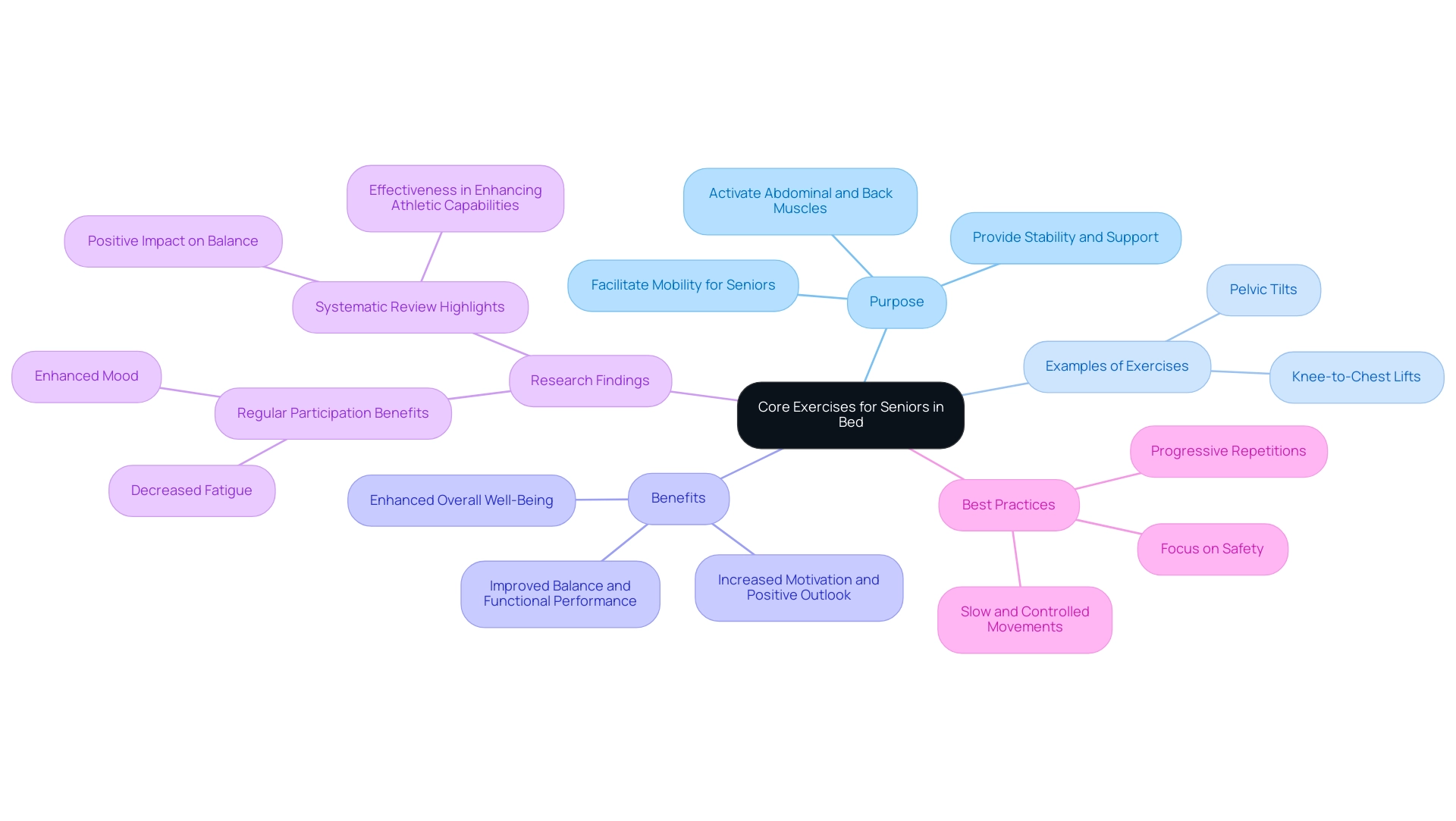
The Importance of Core Strength for Seniors
For older adults, core exercises in bed are essential, as they play a crucial role in supporting balance, stability, and functional independence. A strong foundation significantly reduces the risk of falls, which pose a serious threat to older adults. In fact, falls are the leading cause of injury among older individuals, with statistics indicating that one in four older adults experiences a fall each year.
By engaging in core exercises in bed, seniors can not only prevent falls but also reduce back pain, enhance posture, and improve overall mobility.
Research has indicated that fundamental muscle conditioning can enhance functional fitness and static balance ability in the elderly. A study named "Muscle Stability Training for Seniors" involved thirty participants split into two groups: one performing abdominal strengthening routines and the other participating in traditional strengthening activities over an eight-week duration. The results revealed significant improvements in weight distribution index (WDI) and stability index (SI) for participants in the training group, with a change in the SI score of 0.8±0.23 in the control group.
This highlights the effectiveness of targeted fundamental exercises in enhancing balance and preventing falls, supported by a level of evidence II.
Specialists emphasize the significance of fundamental strength for older adults, pointing out that it directly affects their capacity to carry out everyday tasks, such as rising from a chair or walking, with increased ease and assurance. Kwon-Young Kang, a physical therapy expert, advocates for core exercises in bed as a therapeutic method to enhance muscle stability, stating that it should be considered to improve WDI and SI while serving as a vital fall prevention strategy.
By prioritizing core exercises in bed, older adults can maintain their independence and quality of life, making it a fundamental aspect of their wellness routine.
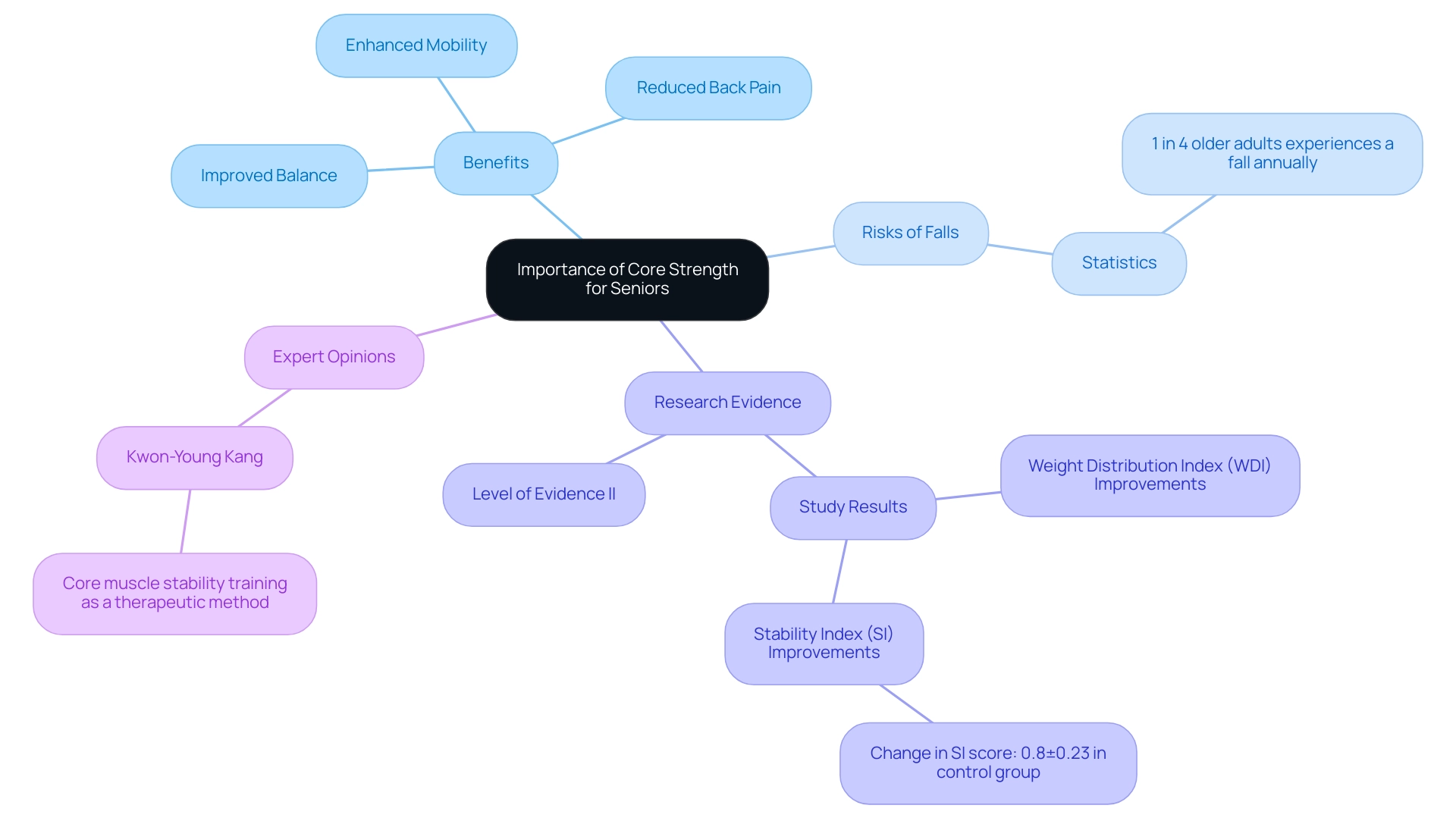
Benefits of Bed Exercises for Seniors
Core exercises in bed for seniors offer significant advantages, particularly in enhancing flexibility, improving circulation, and alleviating stiffness. These gentle movements are especially beneficial for individuals recovering from surgery or managing chronic pain, as they minimize fall risks while promoting mobility. Research indicates that older adults participating in core exercises in bed can experience remarkable improvements in flexibility, with studies showing a potential 30% increase in range of motion over several months.
Moreover, engaging in core exercises in bed for seniors can greatly influence mood and cognitive performance, thereby enhancing overall mental well-being. This practice not only fosters a sense of empowerment but also encourages seniors to take an active role in their health management. For instance, a case study involving elderly individuals recovering from hip surgery revealed that those who integrated core exercises in bed into their rehabilitation reported a 40% faster recovery rate compared to those who did not.
Expert opinions underscore the importance of these activities; geriatric specialists assert that core exercises in bed are a vital component of recovery protocols. They stress that even simple movements can substantially enhance muscle strength and flexibility, which are essential for maintaining independence in daily activities. As one expert noted, "Incorporating core exercises in bed into an elderly person's routine can significantly enhance their quality of life, enabling them to regain strength and confidence."
As we look ahead to 2025, the benefits of core exercises in bed for seniors continue to be validated by ongoing research, highlighting their role in improving physical condition and emotional wellness. Furthermore, studies indicate that individuals who engage in physical activity for at least 30 minutes three times a week are more likely to feel motivated in their jobs—a principle that can also apply to older adults involved in regular physical activities, such as core exercises in bed.
Additionally, a case study titled 'Lower Limb Muscle Strength Evaluation' highlights the detrimental effects of prolonged inactivity on muscular health, emphasizing the necessity of core exercises in bed for seniors. The findings reveal significant declines in muscle strength, underscoring the importance of an active lifestyle, which can encompass core exercises in bed.
Finally, as pointed out by José A. Morais, "The overall duration of the orthostatic test was decreased by 52% after the intervention in both groups," further emphasizing the benefits of physical activity, particularly the role of core exercises in bed for seniors. By incorporating these exercises into their daily routines, seniors can not only achieve physical improvements but also regain a sense of agency over their health.

Step-by-Step Core Exercises for Seniors in Bed
-
Knee-to-Chest Lift: Begin by lying flat on your back with your knees bent. Gently bring one knee up towards your chest, using both hands to hold it in place. Maintain this position for a few seconds to feel the stretch in your lower back, then lower the leg back down. Switch to the opposite leg, repeating this activity 5-10 times on each side to improve flexibility and strength. This activity can be easily monitored and directed through our wellness coaching app, which offers personalized workouts tailored to your needs.
-
Pelvic Tilt: While lying on your back with your knees bent, engage your abdominal muscles to gently flatten your lower back against the bed. Hold this position for a few seconds, focusing on your breathing, then relax. This activity can be done 10-15 times and is effective for enhancing abdominal strength and improving posture. Our app provides daily programming to assist you in staying on track with such activities.
-
Seated Leg Lifts: Sit up in bed with your legs extended straight in front of you. Slowly lift one leg off the bed while keeping it straight, holding it for a few seconds to engage your core. Lower it back down and alternate with the other leg. Aim for 10 repetitions on each side to build strength in your hip flexors and lower abdominal muscles. The app provides video demonstrations to ensure proper form and technique.
-
Side Bends: While seated in bed, place one hand behind your head and lean towards the opposite side, feeling a gentle stretch along your side. Hold this position for a few seconds before switching sides. This activity not only stretches the obliques but also promotes flexibility in the spine. Repeat this 5-10 times on each side. Participating in these activities can be part of a broader wellness program offered by Foresight Health Coaching, which includes nutritional guidance and community support.
Incorporating core exercises in bed for seniors into a daily routine can significantly enhance their physical fitness. Studies indicate that regular engagement in core exercises in bed for seniors can lead to improved balance, reduced risk of falls, and enhanced overall well-being. As specialists suggest, establishing personalized objectives and adhering to a regular workout routine are vital for attaining lasting advantages.
Notably, a study on the long-term effects of physical activity programs highlighted the need for ongoing support to maintain increased activity levels after interventions. Additionally, Danielle Hildreth, RN, CPT, emphasizes that "brisk walking is a low-cost and easy form of physical activity people can use to increase their activity levels." By promoting a nurturing atmosphere for these activities, older adults can experience a more dynamic and satisfying lifestyle.
This aligns with Foresight Health Coaching's corporate membership offerings, which aim to cultivate a healthier and more cohesive team culture, ultimately benefiting organizations and their employees.
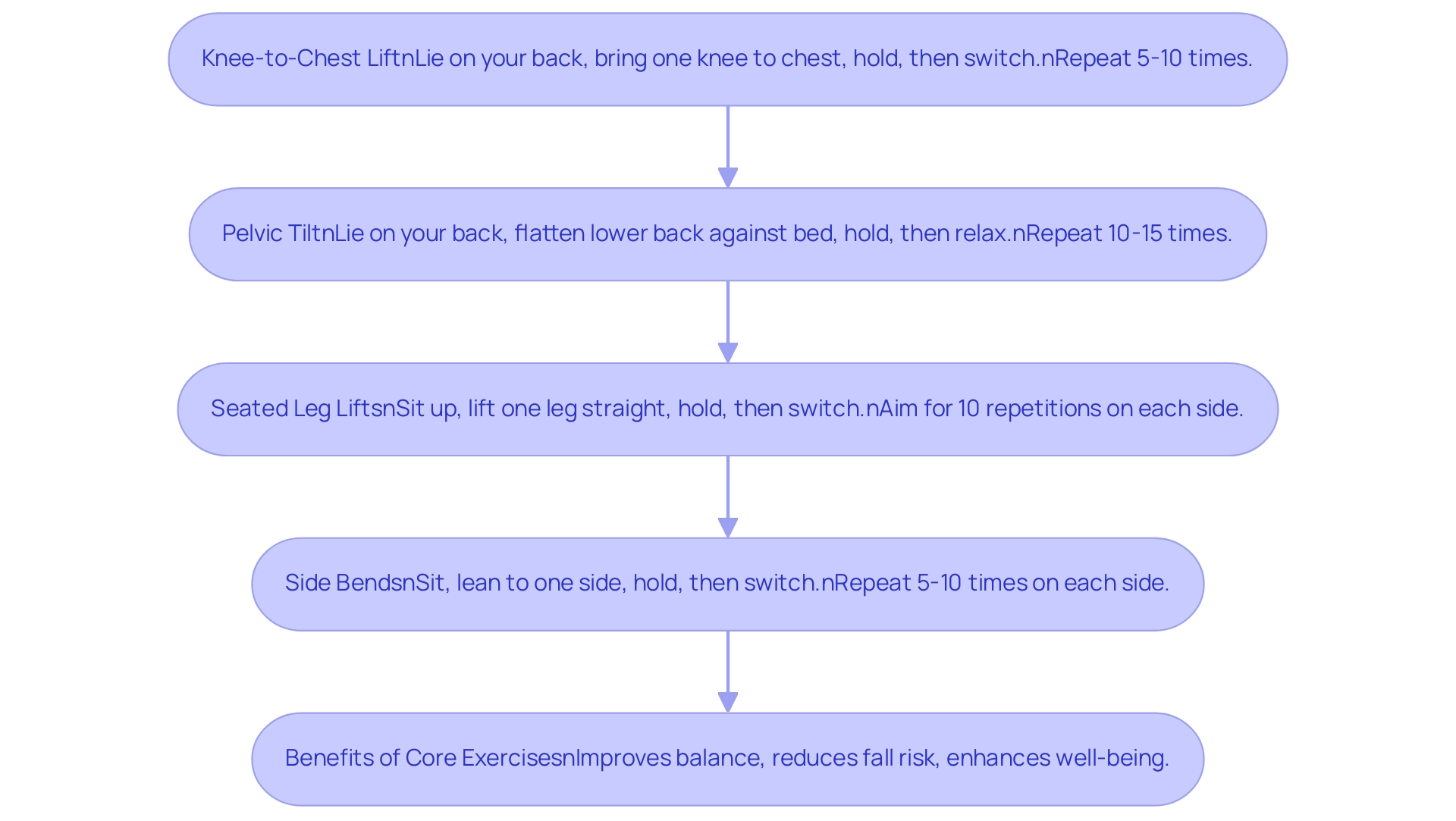
Safety Tips and Modifications for Bed Exercises
-
Consult a Doctor: Prior to initiating any fitness regimen, it is imperative for seniors to consult their healthcare provider, particularly if they have pre-existing medical conditions. This crucial step guarantees that the chosen activities are safe and appropriate for their unique health profiles.
-
Use Support: Leveraging pillows for support can markedly improve comfort and safety during workouts. Pillows can be strategically positioned to adjust body positions, offering essential stability and minimizing the risk of injury.
-
Start Slow: Seniors are advised to commence with a limited number of repetitions, gradually increasing as their strength and confidence grow. This progressive strategy helps to avert overexertion and allows the body to acclimate to new movements.
-
Listen to Your Body: It is vital for seniors to stay attuned to their bodies, ceasing any activity that causes pain or discomfort. Prioritizing safety over intensity is key, fostering a more sustainable and enjoyable physical activity experience.
-
Safety Tips for Working Out in Bed: To further enhance safety, older adults should ensure that their workout environment is devoid of hazards. This includes securing loose bedding and ensuring that the bed is at an appropriate height to prevent falls.
-
Common Injuries Among Seniors: Being aware of prevalent injuries, such as strains or falls, can empower seniors to take proactive measures to avoid them. Incorporating gentle stretches and emphasizing balance can significantly mitigate these risks.
-
Real-World Examples of Modifications: For example, a study titled "Home Full-Body in-Bed Gym Protocol" involving a home-based program for elderly participants demonstrated that tailored in-bed activities led to notable improvements in mental health and pain levels, with 40.9% of participants continuing the activities after six months. Such modifications can enhance quality of life while reducing the risk of sarcopenia.
-
Importance of Consulting a Doctor: Engaging with healthcare professionals not only ensures safety but also offers personalized recommendations that can boost the effectiveness of the fitness program. As Douglas Paddon-Jones from The University of Texas Medical Branch states, "We recommend a broad-based approach to limit losses of muscle mass and function in older adults: a) consume a moderate amount (25-30 g) of high-quality protein with each meal; b) include regular physical activity in close temporal proximity to protein-containing meals."
-
Safety Statistics for Older Adults Working Out in Bed: Recent data reveals that older individuals who participate in regular, modified activities experience lower rates of injury and enhanced overall well-being, underscoring the significance of safe practices in fitness routines. Furthermore, employees who engage in physical activity for at least 30 minutes three times per week are more likely to report feeling motivated at work, highlighting the broader benefits of such activities.
For more information on screening, assessing, and intervening to reduce fall risk, visit the CDC's STEADI website.
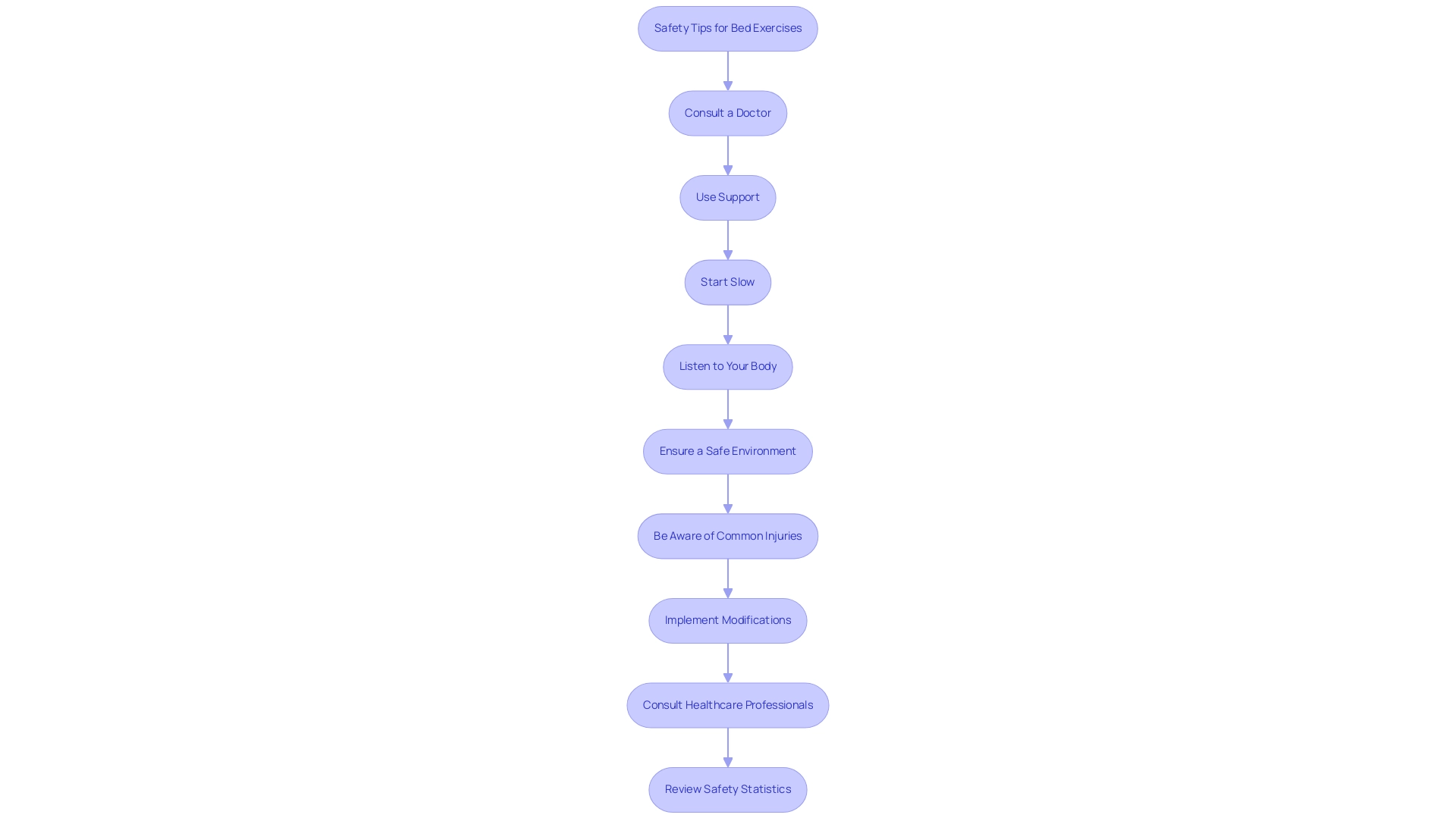
Staying Motivated: Tips for Consistent Exercise
-
Set Realistic Goals: Establishing attainable fitness objectives is essential for older adults. Aim for specific targets, such as completing a certain number of activities each week. This approach fosters a sense of accomplishment and encourages continued participation in physical activity. However, barriers such as lack of insight, goals, and enjoyment can hinder progress, making it essential to address these challenges. Personalized support and guidance from experienced coaches can help seniors set and achieve these goals effectively, allowing them to gain knowledge and skills for a healthier life.
-
Make it Social: Involving family members or friends in fitness routines can transform workouts into enjoyable social events. This not only enhances motivation but also strengthens relationships, making the experience more fulfilling. As noted by Mark DeBeliso from Southern Utah University, fitness professionals should not underestimate the importance of external motivating factors on adherence to physical activity among elderly individuals. Foresight Health Coaching emphasizes the significance of community and support in achieving wellness goals, assisting older adults in taking control of their health and well-being.
-
Track Progress: Maintaining a journal or using a calendar to log exercise sessions can significantly boost motivation. Recording progress offers a tangible feeling of accomplishment and motivates older adults to remain dedicated to their fitness journey. Research indicates that a structured intervention lasting 24 weeks can effectively support these strategies. Our health coaches can assist in tracking progress and celebrating milestones, reinforcing positive behavior.
-
Celebrate Success: Recognizing and celebrating milestones, regardless of their size, reinforces positive behavior and sustains motivation. Acknowledging accomplishments can motivate older adults to maintain their workout habits and pursue additional advancements. The reasons for daily physical activity routines among older adults, as emphasized in a study, show that fitness and appearance are key factors, indicating that celebrating progress can be especially significant. By collaborating with Foresight Health Coaching, organizations can promote a culture of wellness that honors individual and team achievements.
Incorporating these strategies can lead to increased compliance with exercise programs among older adults. By fostering a supportive environment and setting realistic expectations, seniors can enhance their overall well-being and maintain an active lifestyle. Furthermore, organizations investing in Foresight Health Coaching's partnership can nurture a stronger team culture, ultimately benefiting both individual employees and the organization as a whole.
Take the first step towards a healthier, happier, and more cohesive team by contacting us today! Additionally, consider our free 7-day trial promotion for our transformative health coaching app to support your wellness goals.

Incorporating Core Exercises into Daily Life
-
Morning Routine: Beginning the day with fundamental workouts can significantly enhance energy levels and mental clarity. Engaging in just 10-15 minutes of core exercises in bed for seniors each morning not only boosts physical strength but also sets a positive tone for the day ahead. Research indicates that older adults should aim for at least 150 minutes of moderate physical activity weekly, making morning routines an ideal opportunity to meet this goal. By incorporating these activities, seniors contribute to a healthier, happier, and more cohesive team culture, which is a key focus of Foresight Health Coaching's corporate partnership. Foresight offers tailored health coaching services that encompass fitness coaching, nutritional guidance, and wellness workshops, ensuring employees receive the support they need to thrive, including in-person wellness talks and comprehensive pantry services as part of our corporate memberships.
-
Before Sleep: Including gentle stretches and abdominal workouts before bedtime can greatly enhance relaxation and sleep quality. These calming activities help release tension accumulated throughout the day, promoting a restful night’s sleep. Establishing a bedtime routine that incorporates core exercises in bed for seniors can also aid in maintaining flexibility and balance, which are crucial for seniors. Foresight's wellness coaching app provides personalized guidance to help users integrate these practices into their nightly routines, enhancing their overall wellness journey.
-
Breaks During the Day: Taking short pauses throughout the day to perform simple activities can effectively combat the negative effects of prolonged inactivity. Even a few minutes of core exercises in bed for seniors can enhance circulation and reduce fatigue, contributing to overall well-being. Studies show that regular movement during the day can lead to improved concentration and productivity, making these breaks beneficial for both physical and mental health. This aligns with the outcomes of Foresight Health Coaching's programs, which emphasize reduced absenteeism and enhanced employee satisfaction through structured wellness initiatives, including our corporate membership offerings.
-
Combine with Other Activities: Pairing core exercises in bed for seniors with daily tasks, such as watching television or reading, can transform fitness from a chore into an enjoyable part of the day. This approach not only promotes consistency but also assists older adults in seamlessly incorporating physical activity into their lives. As the saying goes, "Strength training: No, we're not talking about bench pressing 100 pounds!" By integrating exercise into their daily routine, seniors can enhance their overall well-being and sustain a higher quality of life. The Foresight Health Coaching app also features direct messaging with coaches for personalized support, fostering community engagement and motivation, which sets us apart from other health coaching services.
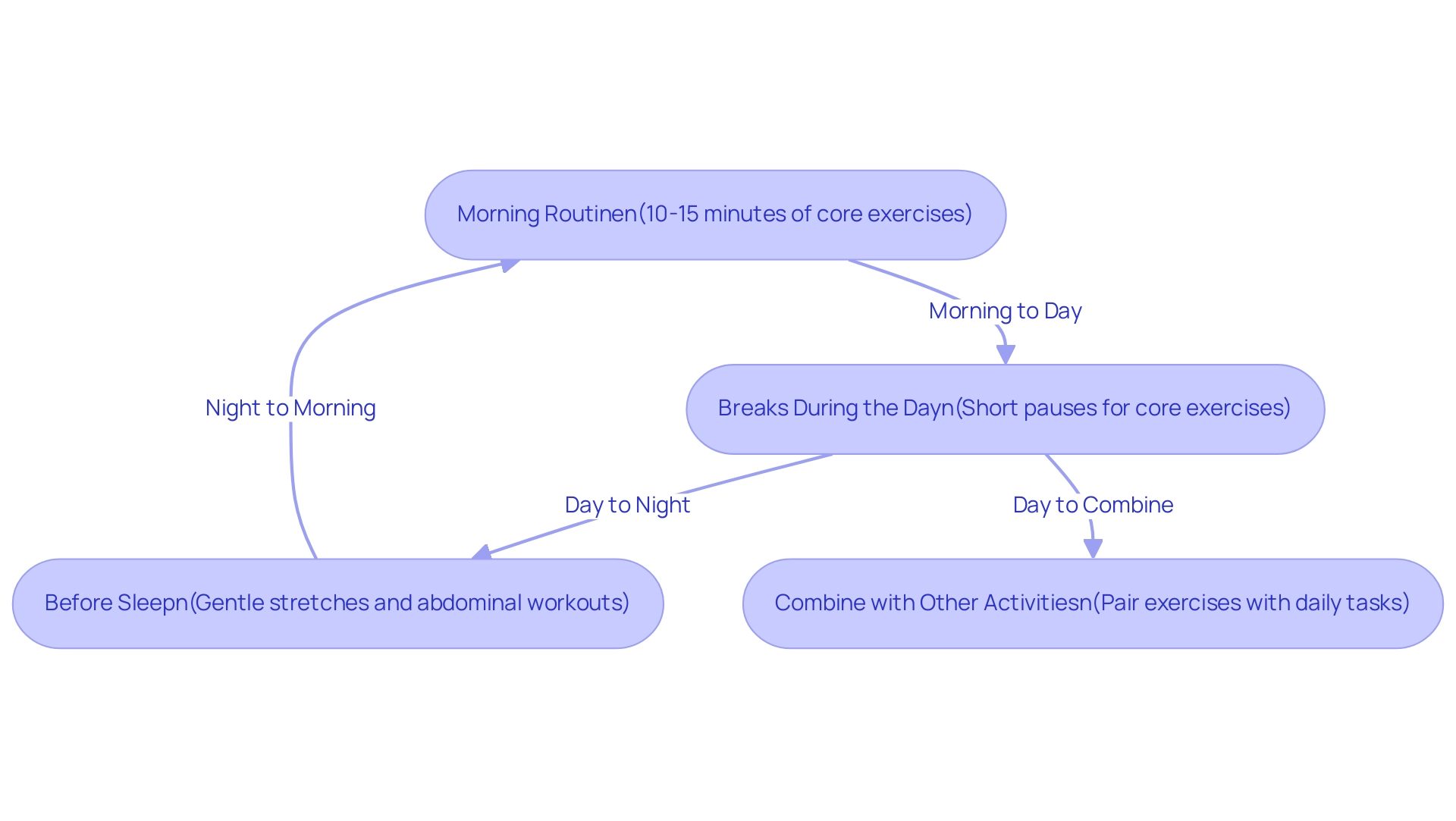
Conclusion
Incorporating core exercises into the daily routines of seniors can lead to remarkable improvements in both physical and mental well-being. Engaging in simple movements like knee-to-chest lifts and pelvic tilts while in bed not only enhances core strength but also supports balance and stability—crucial factors in fall prevention. Research consistently demonstrates that these gentle exercises significantly reduce the risk of falls, alleviate back pain, and improve overall mobility, thereby empowering seniors to maintain their independence.
Moreover, the benefits extend beyond physical health. Regular engagement in core exercises has been linked to enhanced mood and cognitive function, contributing to a more positive outlook on life. By making these exercises a part of their morning or bedtime routine, seniors can cultivate a sense of accomplishment and agency over their health. Safety measures, such as consulting healthcare providers and starting slowly, can further ensure that these workouts remain both effective and enjoyable.
As the focus on tailored fitness solutions for seniors continues to grow, it becomes increasingly clear that integrating core exercises into daily life is a vital step towards fostering a healthier, more active lifestyle. By prioritizing these accessible workouts, seniors can not only improve their physical fitness but also enrich their overall quality of life, setting the stage for a happier and more fulfilling existence. Investing in health and wellness through such practices benefits individuals and creates a supportive community that enhances collective well-being.
Frequently Asked Questions
What is the purpose of core exercises in bed for seniors?
The purpose of core exercises in bed for seniors is to activate the abdominal and back muscles, providing essential stability and support, particularly beneficial for those facing mobility challenges.
What types of exercises are recommended for seniors to do in bed?
Gentle movements such as knee-to-chest lifts and pelvic tilts are recommended as they can be comfortably performed while lying down and integrated into a morning routine or warm-up.
How do core exercises in bed benefit seniors?
Core exercises in bed enhance balance, stability, and functional independence, reduce the risk of falls, alleviate back pain, improve posture, and increase overall mobility.
What does research say about the effectiveness of core exercises for seniors?
Research indicates that incorporating fundamental muscle conditioning can significantly enhance functional fitness and static balance in the elderly, with studies showing improvements in stability and weight distribution.
What safety practices should seniors follow when performing core exercises?
Seniors should focus on slow and controlled movements to reduce the risk of strain or injury, starting with a few repetitions and gradually increasing as strength and comfort improve.
How do core exercises impact mental well-being for seniors?
Engaging in regular physical activity, including core exercises, has been linked to increased motivation and a more positive outlook on life, contributing to improved mental well-being.
Why is fall prevention important for older adults?
Falls are the leading cause of injury among older adults, with statistics showing that one in four experiences a fall each year. Core exercises help prevent falls by enhancing stability and strength.
What expert opinions support the incorporation of core exercises in bed for seniors?
Experts emphasize that fundamental strength directly affects seniors' ability to perform everyday tasks with ease, and core exercises are advocated as a therapeutic method to enhance muscle stability and prevent falls.

